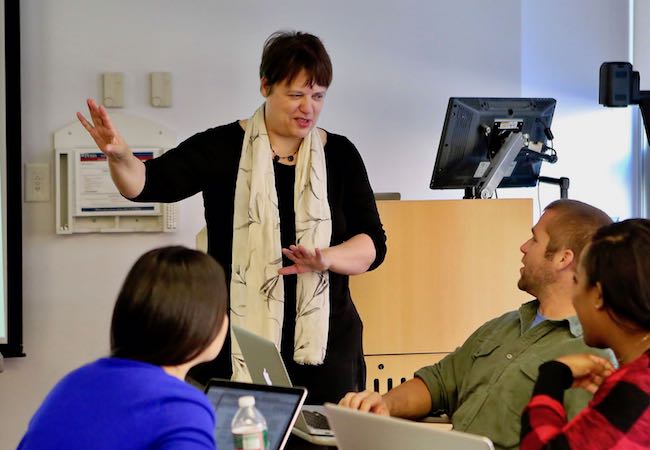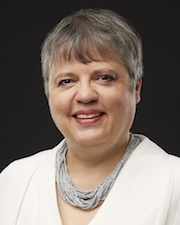What to do when computers are everywhere

Since the turn of the century, Americans have become accustomed to interfacing with digital technology. That doesn’t mean we understand that technology any better.
The Facebook “fake news” scandal of the 2016 election showed the danger of having a society that doesn’t understand the apps and programs it depends on. If we don't do a better job preparing today’s children to live in an interconnected world, Penn GSE’s Yasmin Kafai says it will only get worse.
Kafai, a learning scientist who has designed tools and communities to promote coding, crafting, and creativity, believes we need to change how we think about teaching and learning, while making sure every child has a chance to develop these vital skills.
Recently, Kafai was a featured speaker at a Nobel Prize Dialogue conference on the future of learning. Held in Santiago, Chile, the conference brought together leading thinkers across disciplines from around the world.
We sat down with Kafai to discuss some of the big issues that came up in Santiago, including the digital divide, preparing teachers for digital learning, and what happens when we can’t trust algorithms.
Q: Computing classes are becoming more common in schools. If schools continue to ramp up, will students get the skills they need or do we need something more drastic?
A: Many students, parents, and teachers think about computer science as only what happens on the screen, not realizing that in today’s internet of things, computing has already moved out into the real world. We need to develop curricular and instructional activities that include these kinds of applications in students’ learning and teaching.
We often frame this conversation in terms of preparing students for careers and college. But these skills are important for everyday life. We now know we can’t trust technology companies with the data we give them. We have to develop critical skills to assess what data is being collected. We need to understand how fake news is created, and how the networks that pass that fake news along — networks with hundreds of millions of users — operate.
This is a real challenge because, lo and behold, most users have little technical understanding of any kind. How do we change that? How do you build a foundation in elementary school, leveling up to middle and high school? We can’t assume everyone will go to college and study computer science. This is the new literacy. It’s the future of learning.
Q: How should we be shifting our focus?
A: The last 10 years, we’ve very much focused on internet literacy: how do you search and evaluate the results? That’s still an important question, but now the lessons have to go much deeper. How do you know the algorithm that found the information isn’t biased?
How do we as end users, as normal citizens, have to develop the capacity to judge that? If we can’t, we are at the mercy of big tech companies, and our knowledge of the world will be limited by what people in Silicon Valley and a few other places decide.
Q: Right now, that type of learning you are talking about is most likely to happen in a college course, if it happens at all. Is that too late?
A: We can’t wait for kids to get to college. They start using apps that collect their data well before going to college.
We know algorithms can be biased. Facial recognition software is just one area where we see this. It’s not that algorithms are bad. It’s that people who design the training sets — the way the programs work — often don't think about users who aren’t white males. But the biases can affect all users.
Most of these programs are explicitly not being transparent about what’s going on behind the curtain. How can we lift the curtain and see what’s going on behind the curtain? What goes on behind the social networks? How do we give a voice in the digital public square to people who are not computer scientists, software engineers, or data scientists?
Q: This comes back to improving computing classes in schools. How should we start to bring more technology into schools?
A: We need to realize the reality that in cities like Philadelphia, 40 percent of students who come from low-income communities do not have access to computers or the internet in their homes. If we are talking about bringing technologies into schools, we need to make sure everyone has access.
You can do computer science without computers. There is a great program called CS Unplugged, for example. But in the end, the exciting and rich learning experience comes from learning how to program an application on a computer and see it come alive, and really experience technology being made.
Q: So this isn’t just an educational challenge, it’s also an equity challenge.
A: If we think about bringing technologies into schools, we need to make sure everyone has access. If we don’t, those who are privileged to have access at home – and not just access to the hardware, but access to skills, access to a summer camp or an after-school activity focused on computing – will be those who get ahead.
Despite an awareness of the digital divide, the differences in access to digital technology have only grown over the last 20 years. We have to provide extra resources right now, starting from a very young age, to give everyone a chance to catch up.
Q: Your work has shown that good computer science education requires more than putting computers in classrooms. Educators need to integrate technology into the curriculum and the learning process. Do we need to change how we prepare and support teachers?
A: We realize we need to develop the competencies in this area, but we’re faced with a teacher workforce that contains very few teachers familiar with computer science. Schools and colleges of education don’t prepare teachers to learn about and integrate computer science activities into their teaching. When teachers are prepared without this emphasis, and someone later tells them they need to integrate computer lessons, they have no models for success.
That is a gigantic challenge, and the United States is not alone. It’s a global challenge. Governments and school districts around the world are struggling with creating and implementing new curricula and getting teachers on board to put this into their classrooms.
But our work with educators has shown that when people experience a great lesson that incorporates computing, they see their students react, and they want to go deeper. Every year in December there is a great activity called the Hour of Code. That was started to give everyone a little taste of what coding could be. It was an appetizer.
That’s not enough. Now that people have had the appetizer, they want the full meal. And the full meal is stuck in the kitchen! It’s time to get it on the plate.

